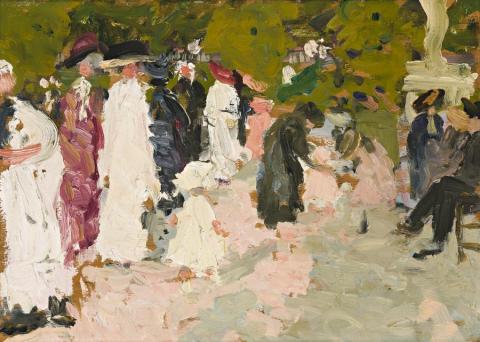LUXEMBOURG GARDENS, PARIS, c.1906-10
ETHEL CARRICK FOX
oil on wood panel
24.5 x 34.5 cm
Gerald Griffin, Melbourne
Thence by descent
The Estate of Eileen Griffin, Melbourne
After Ethel Carrick's marriage to Emanuel Phillips Fox in London in 1905 they moved to Paris, living at 65 Boulevard Arago near the Luxembourg Gardens. The proximity of the gardens provided an ideal subject for their art as seen in Phillips Fox's (Figures in a Park, France) c.1907-09, in the collection of the S.H. Ervin Gallery, Sydney, and Carrick's Luxembourg Gardens c.1909. Carrick painted a number of Luxembourg Gardens paintings during this time, the earliest known being one dated 1906 and included in her Melbourne exhibition of two years later. The period was also marked by a close friendship between the Foxes and fellow Australian artist Rupert Bunny and his French wife Jeanne. For a while Phillips Fox's paintings showed an affinity with Bunny's, and Bunny painted his own series on the Gardens - The Stragglers c.1907 in the collection of the National Gallery of Victoria, Melbourne, and a number painted in the spring of 1909. Of the latter, In the Luxembourg Gardens c.1909 (private collection, Perth), shares with Ethel an interest in painting women and children relaxing or playing in the gardens, a marble statue nearby. It would be a pleasing coincidence to think that they painted together. The larger and more composed Bunny work was destined for the walls of the Paris New Salon, Carrick's delighting in the freedom and verve of an immediate impression. Significantly, Bunny gave his painting to the English artist Henry Edward Giles, who was working in Phillips Fox's Paris studio at this time. The spontaneity of Carrick's technique and engaging pictorial vivacity suggests that Luxembourg Gardens was most likely painted in the open air directly from the motif. The liveliness of the impression captures the passing moment to perfection, the shimmering paint giving a rustling feeling of engaging conversation and movement to the promenade of fashionably dressed mothers, nannies, and the children in their care. All is enveloped in a sparkling atmosphere of dappled sunlight. While Bunny's Luxembourg Gardens paintings embraced such subjects as Dejeuner sous les arbres, playing bridge and croquet, Carrick's brush included the pleasure of listening to music as seen in Concert in the Luxembourg 1909, a panel painting of similar size in the collection of the Castlemaine art Gallery and Historical Museum.
DAVID THOMAS
